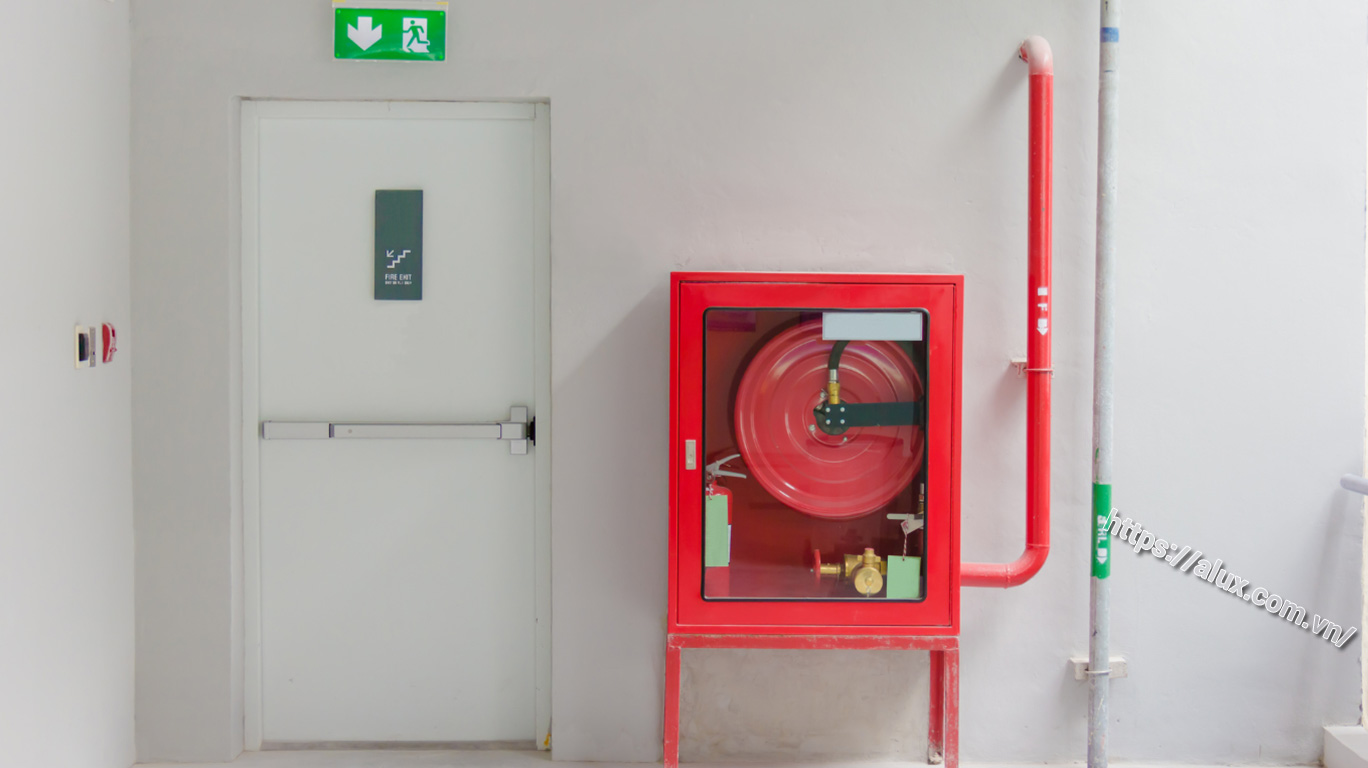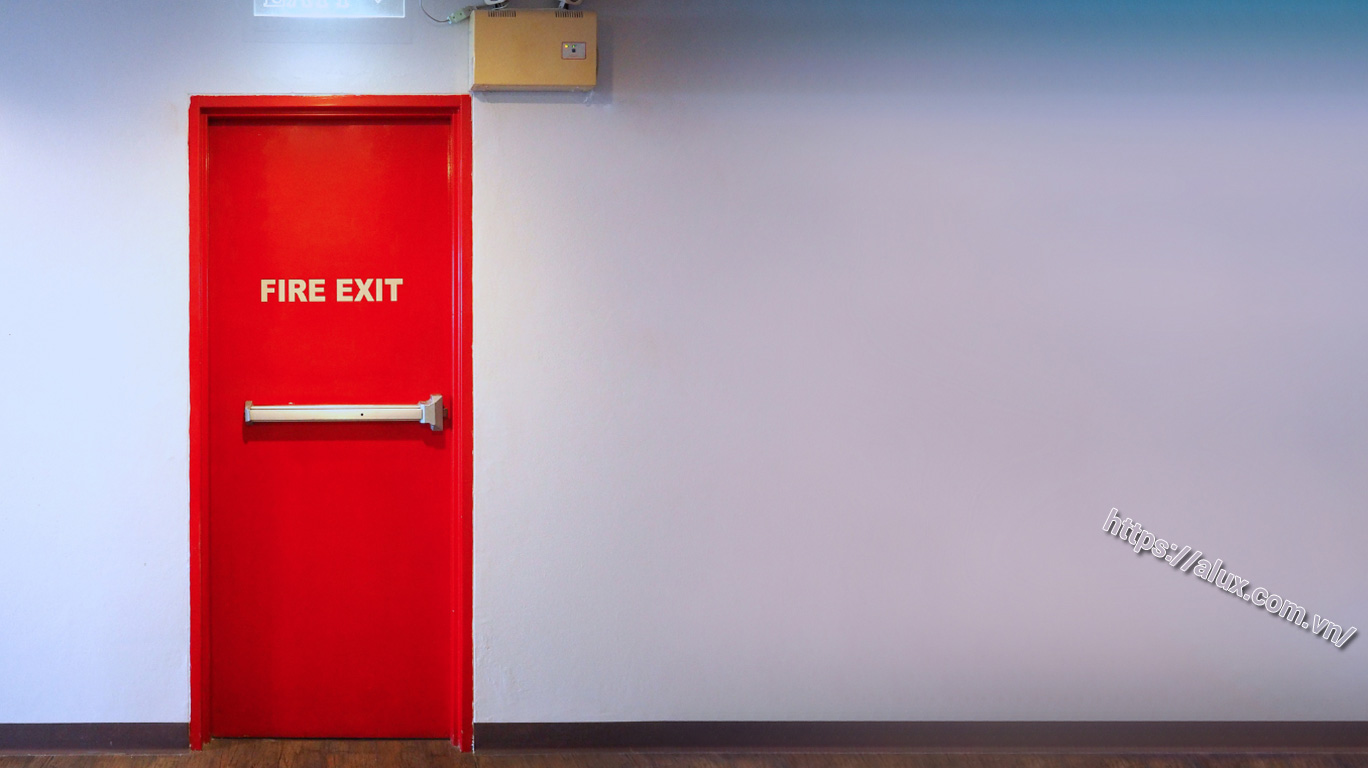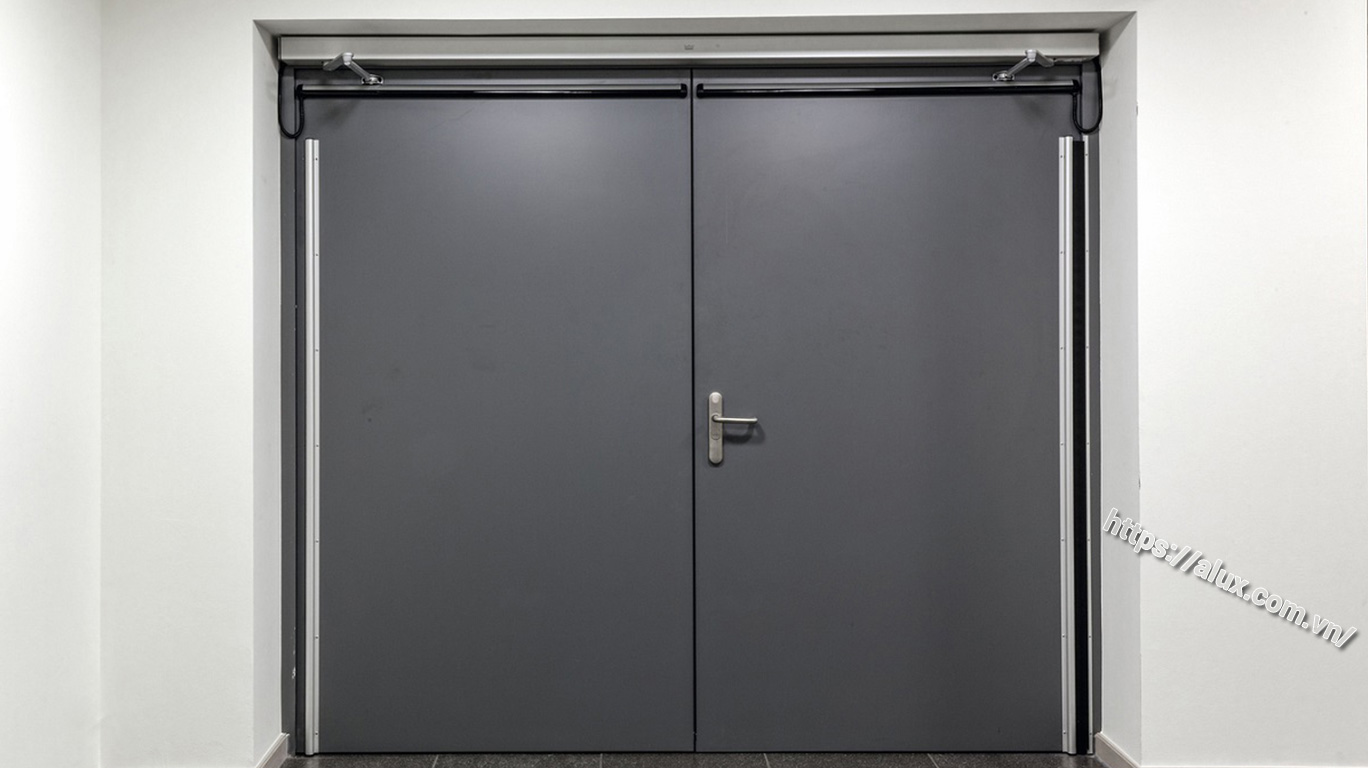Let’s explore the technical requirements for fire-resistant doors with Alumax. Fire-resistant doors are not just mere products or components in design and construction; in some projects, it is mandatory to install fire-resistant steel doors to ensure safety in the event of fire or explosions. Therefore, standards for fire-resistant doors are established to assess their quality, safety, and operational effectiveness.
Currently, fire-resistant doors, ensuring safety in various construction projects and homes, have been implemented nationwide. However, there may still be concerns about the safety and fire resistance of these doors. Many people may not fully understand why these doors, despite being a special type, possess the ability to resist fire when, theoretically, fire can consume everything.

1. Technical Requirements for Fire-Resistant Doors
The standards for fire-resistant steel doors typically include three time ratings: 60 minutes, 90 minutes, and 120 minutes. All three levels must meet the following technical requirements:
1.1. Steel Material for Doors
Different manufacturers use varying raw materials, resulting in differences in the quality of the steel used for doors. Additionally, the thickness of the steel for door leaves and frames varies between manufacturers. For example, Alux fire-resistant doors use electro-galvanized steel with thickness ranging from 0.8mm to 1.2mm for leaves and 1.2mm to 2mm for frames. Higher steel thickness correlates with increased fire resistance.
1.2. Fire-Resistant Core Material
Apart from the steel material contributing to fire resistance, the inner core material enhances the fire-resistant capabilities. Depending on the manufacturer and specific fire resistance requirements, different fire-resistant core materials are used. For instance, doors with a 60 or 90-minute rating commonly use Honeycomb Paper, while doors with a 120-minute rating may incorporate fiberglass wool or additional materials.
1.3. Sealing Components
If a fire-resistant door cannot completely seal, it fails to ensure fire resistance. Even a small opening can allow fire and smoke to spread to other areas. Alux fire-resistant doors have multiple components to enhance door sealing, with a focus on three key accessories:
Hydraulic door closers enable the door to close automatically when opened, ensuring prompt closure during emergencies when individuals may panic and not close the door immediately. Doorsill serves as an accessory to block and fill the gap between the door leaf and the floor. Rubber gaskets surround the door, covering gaps between the door leaf and frame. This accessory aids in sound insulation, easy opening and closing without significant noise, and, when exposed to high temperatures, the gaskets expand to ensure a tight seal, eliminating any gaps.
1.4. Other Accessories
In addition to the sealing components mentioned above, fire-resistant doors require other essential accessories, including:
Door hinges: Many contemporary doors use stainless steel hinges. Alux fire-resistant doors use hinge leaves made from SUS304 stainless steel, providing excellent fire resistance, resistance to warping, and deformation under high temperatures and external forces. Door locks or panic bars must be made from steel and possess good thermal insulation properties to prevent burns when opening the door. Glass windows (if applicable) must be made from fire-resistant tempered glass.
1.5. Door Installation Location
When purchasing a fire-resistant door, determining the installation location and specific usage requirements is crucial to selecting the most suitable door leaf. For example, doors installed in construction projects may differ from those used in residential homes. Emergency exit doors will differ from electrical or technical room doors. The size of the door may also influence the choice between single or double fire-resistant doors

1.6. How to Verify Fire-Resistant Door Standards
How can we determine if a steel door meets fire-resistant standards? There are several ways to ensure that the provided fire-resistant door meets quality standards.
Legal Documentation
High-rise buildings and structures with a high risk of fire explosion have regulations regarding the fire resistance level of doors. Therefore, when purchasing from a manufacturer, it is essential to request full legal documentation and accompanying fire-resistant certificates. This helps minimize the risk of buying counterfeit or low-quality steel doors.
Check Important Specifications
For fire-resistant steel doors, there are crucial specifications to check, including fire resistance duration (measured in minutes), thermal insulation capability (denoted as I), load-bearing capacity (denoted as R), and durability (denoted as E). Depending on the type of construction, suitable fire-resistant door specifications can be selected. These parameters can be referenced in national technical standards for fire safety in buildings. For projects without specific fire-resistant door standards, one may opt for doors with lower fire resistance levels to save costs.
Inspect the Fire Endurance Limits of Other Components
In addition to fire-resistant door standards, other components within fireproof areas also need to meet certain standards. Specifically, TCVN 6160: 1996, which covers the design requirements for fire-fighting rooms in high-rise buildings, stipulates the fire endurance limits for related components as follows:
Doors, Windows, Gates
Doors, windows, and gates in areas where fire-resistant doors are installed must be made from fire-resistant materials. The minimum fire resistance duration must be 45 minutes.
Fire Partition Walls
Fire partition walls in areas such as roofs, basements, doors to roofs, etc., must be made from non-combustible materials. The minimum fire endurance limit for fire partition walls, as per regulations, is 40 minutes.
Doors in Special Function Areas
Certain special function areas, such as electrical rooms, technical rooms, basement floors, stairwells, etc., are required to install fire-resistant doors. Fire-resistant steel doors installed in these areas must have a minimum fire endurance duration of 45 minutes. Additionally, all doors must ensure automatic closing mechanisms.

2. New Regulations Regarding Fire-Resistant Doors
In Vietnam, there are numerous legal regulations related to fire prevention that investors need to be aware of. Among them, the standard TCVN 6160:1996 regarding the design requirements for firefighting rooms in high-rise buildings is crucial before a project becomes operational. This standard outlines mandatory requirements that offices, apartments, and high-rise buildings must meet.
Fire-resistant doors must undergo inspection according to current regulations in Vietnam, issued by the Fire Prevention and Fighting Police Department or authorized inspection agencies.
As per the regulations for fire-resistant doors:
In section 5.2 of TCVN 6160:1996, the minimum fire endurance limits for fire-resistant components are stipulated as follows:
Windows and gates in fire partition walls must be made of non-combustible materials and have a fire endurance limit of not less than 45 minutes.
Fire partition walls must be made of non-combustible materials and have a fire endurance limit of not less than 45 minutes.
Doors and windows in fire partition walls, doors to basements, doors to roofs must be made of non-combustible materials and have a fire endurance limit of not less than 40 minutes.
Doors in stairwells, technical rooms, and beneath basements must also be fire-resistant doors. They need to have an automatic closing mechanism and withstand fire for 45 minutes or more.
According to regulations, fire-resistant doors with a 60-minute fire endurance limit must have a structure that remains undamaged when exposed to a temperature of approximately 1,000 degrees Celsius. The temperature will gradually increase and reach a maximum of about 1,000 degrees Celsius within 60 minutes. Meanwhile, the door’s surface not in direct contact with fire should not exceed a threshold of 220 degrees Celsius.
Some general safety requirements for fire-resistant steel doors:
Fire-resistant doors must meet basic requirements, regardless of the duration of heat resistance and fire resistance. These common requirements include:
Door leaf using cold-rolled steel 0.8mm – 1.2mm thick, with a leaf thickness of 50mm – 70mm.
Door frame using hot-rolled steel 1.6mm thick. Frame thickness is 100mm – 110mm.
Door core using magnesium oxide fire-resistant material (refer to the article ‘What is Magnesium Oxide Fire-Resistant Door Core Material?’).
Smoke-resistant rubber gaskets that, when the door is closed, seal tightly and operate smoothly.
Hydraulic door closer to keep the door in the closed state.
If any of these factors are missing, the door will not meet fire-resistant standards or ensure safety in the construction design.

3. Top 3 Common Types of Fire-Resistant Doors Nowadays
Currently, there are numerous types of fire-resistant doors on the market with different time durations, such as 45 minutes, 60 minutes, 70 minutes, 90 minutes, 120 minutes, 150 minutes, and 180 minutes.
Among the fire-resistant doors with different time durations, the 60-minute, 90-minute, and 120-minute fire-resistant doors are more commonly used.
60-Minute Fire-Resistant Doors: This is the most widely used type today and is applied in residential buildings, high-rise apartments, etc. It is composed of two sheets of 0.8mm thick galvanized steel, providing fire resistance for up to 60 minutes.
Note: After 60 minutes, the fire-resistant door may deform, lose its insulation capability, and be unable to prevent the spread of fire to other areas. This type of door is often installed in residential houses as main doors, bedroom doors, basement doors, and roof access doors.
90-Minute Fire-Resistant Doors: Similar to the 60-minute fire-resistant door, this type is composed of two sheets of 1mm thick galvanized steel, providing heat resistance for 90 minutes. Nowadays, 90-minute fire-resistant doors are installed in large-scale projects such as administrative buildings, residential areas, places with crowded corridors like hospitals, restaurants, and supermarkets.
120-Minute Fire-Resistant Doors: Similar to the above two types, this door is also composed of two sheets of 1mm thick galvanized steel. However, it is designed with additional rockwool in the core to enhance fire resistance and insulation, rather than using honeycomb paper like the other two types. With a fire resistance capability of up to 120 minutes, this type of door is often installed in condominiums, commercial centers, office buildings, or places with high population density.
Fire-resistant doors meeting standards help ensure the safety of both property and human lives. Therefore, in various constructions, from residential homes to high-rise buildings, it is advisable to install these types of doors
——————————————–
ALUMAX VIETNAM JOINT STOCK COMPANY
Headquater: No.70 Nam Duong str, Thuong Thanh ward, Long Bien distric, Hanoi city.
Hotline: 0961 362 362
Website: www.alux.com.vn

 Tiếng Việt
Tiếng Việt





